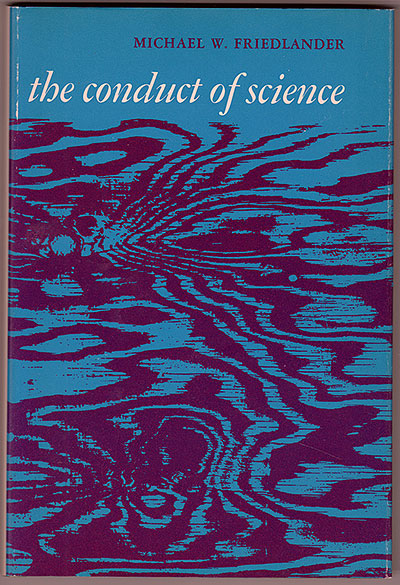Book: The Conduct of Science (1972)

At the Fringes of Science cover
Prentice-Hall, 1972.
Publisher's blurb (from dust cover)
This introduction to the methods and conduct of scientific research provides the key to a better understanding of the role of science in the modern world.
Although nontechnical introductions to science have traditionally concentrated on the elementary presentation of scientific content, The Conduct of Science goes beyond this narrow sphere to explore the ways in which scientific decisions are reached, and the many ways in which they affect society.
By providing a view of the inner workings of the scientific community, of the day-by-day conduct of scientifc research, and of contemporary problems facing the scientist in the university and in society, this unique volume probes deeply into areas long closed to the layman and too often ignored even by scientists.
After a discussion of the social direction of scientsts, the book turns to the dissemination of scientific information, both within the scientific community as well as among the general public.
Why do scientists usually accept the authority of other scientists' published work? What are the essential features of the scientific controversy and how are they resolved? An understanding of these basic attitudes and procedures is invaluable to the layman, especially today when science is becoming increasingly involved in issues of public concern.
This book explores new roles and decisions in organized science and examines the university as the present focal point of basic research. Of special interest are sections on the applications ('relevance') of the fruits and techniques of research, and the growing relation between science and government.
The final chapters deal with criteria for the establishment of values and priorities and the responsibilities of scientists, as well as nonscientists, to exert informed controls on the future uses of science.
As a survey of the growing interdependence between the scientific world and society at large, The Conduct of Science is of vital interest to everyone who is concerned that future growth and application of science be beneficial.
Table of Contents [Click triangle or this line.]
The Social Direction of ScientistsSpreading Scientific Information
Certainty and Authority in Science
Controversy: The Resolution of Scientific Conflicts
Organized Science--New Roles and Decisions
The University: A Home for Research
The Application of Science: Relevance
Science and Government
Values, Priorities, and Choice
Responsibilities and Obligations.
Reviews and Publicity (from many angles)
- Review by Richard Hull from Philosophy of Science magazine, Vol 42, No 1, March 1975. [DOI] [Cambridge Univ Press.] Oddly, the identical review (same journal) also appears on the University of Chicago Press, web site but with the identical DOI number (different URLs, however).
- Review by Robert H. March in the American Journal of Physics (American Association of Physics Teachers), 1973. [DOI]
-
What Science is Really Like"
Review by John A. Day in The Physics Teacher, Vol 11, No. 6, 1973. [DOI] [Note withering review of an unrelated book by Edward Condon on the same page.] - From the ERIC database (Education Resources Information Center,
from the U.S. Department of Education's Institution of Education Services)
ERIC entry
This book was designed to be a useful adjunct to any introductory science course. Topics included have been tested in a course for nonscience students. The author's objective is to provide students with a basic understanding of the workings of science and its relationship to society. Ten chapters are included: The Social Direction of Scientists; Spreading Scientific Information; Certainty and Authority in Science; Controversy: The Resolution of Scientific Conflicts; Organized Science--New Roles and Decisions; The University: A Home for Research; The Application of Science: Relevance; Science and Government; Values, Priorities, and Choice; and Responsibilities and Obligations. The book also contains a lengthy appendix; a bibliography of books, resource letters in physics, periodicals, and recent publications; and an index.
Other citations and references
-
Computer science curriculum: technography, technocracy, technology, or theology?
ACM SIGCSE Bulletin, VOl 17, No. 4, Dec 1985.
[DOI]
ACM is the Association for Computing Machinery, a venerable computer science organiztion. SIGCSE is the Special Interest Group on Computer Science Education. - Scence Funding: Politics and Pork Barrel by Joseph P. Martino (Transaction Publishers, New Brunswick & London, 1992)
- On Publishing Scientific Papers in Peer-Reviewed ISI-Covered Journals, by Teodora Bagarinao SEAFDEC Aquaculture Department 5021 Tigbauan, Iloilo Philippines, The Phillipine Scientist, Vol 31, 1994.
- Author note in the Skeptical Inquirer, 2006.
- The book is cited on the " science" page on the web site, The Skeptic's Dictionary.